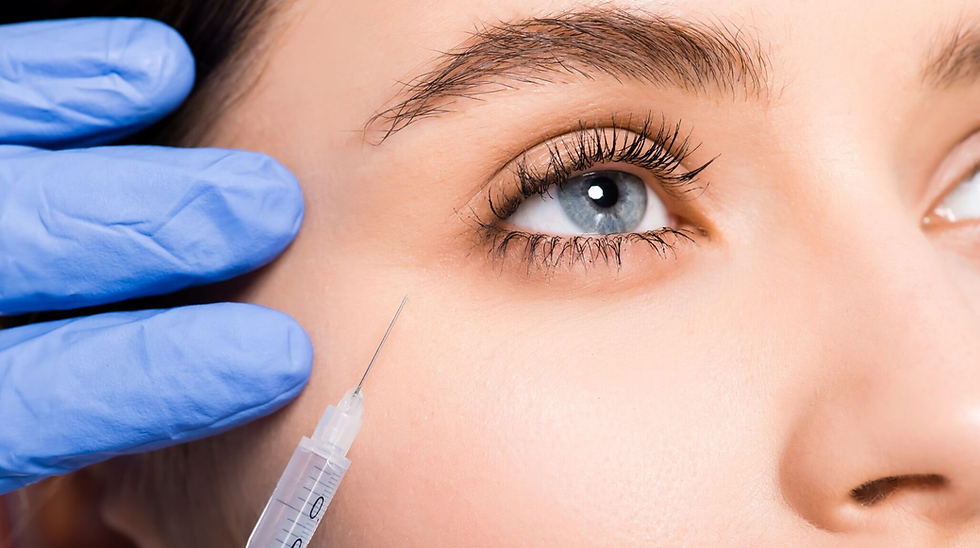Can Under Eye Fillers Help with Dark Circles?
- aesthatic clinic
.jpg/v1/fill/w_320,h_320/file.jpg)
- Nov 24, 2024
- 3 min read
Dark circles under the eyes are a common concern for many, often associated with tiredness, aging, or genetics. Under-eye fillers, a popular non-surgical treatment, can effectively address certain types of dark circles, depending on their underlying cause. Let’s explore how fillers work and when they might be the right solution. This Article delves into the details of Under Eye Fillers in Dubai.
Understanding the Causes of Dark Circles
Dark circles can result from various factors, and not all are treatable with fillers. Common causes include:
Hollowing or Volume Loss
As we age, the skin under the eyes can thin, and fat loss may create a hollow appearance known as tear troughs.
This shadowing effect can exacerbate the look of dark circles.
Pigmentation
Hyperpigmentation from genetics, sun exposure, or skin conditions can create dark discoloration under the eyes.
Fillers are not effective in treating pigmentation-related dark circles.

Vascular Issues
Visible veins or pooling of blood under the thin under-eye skin can give a bluish or purple tint.
Fillers may help reduce the appearance of vascular darkness by providing a cushioning effect.
Lifestyle Factors
Poor sleep, stress, and dehydration can make dark circles more prominent.
These factors require broader lifestyle changes rather than fillers.
How Under Eye Fillers Work for Dark Circles
Under-eye fillers, typically made from hyaluronic acid, are injected into the tear troughs to:
Restore Volume
Fillers plump up hollow areas, reducing shadows and creating a smoother, more youthful contour.
Improve Light Reflection
By evening out the surface under the eyes, fillers can improve the way light reflects on the skin, reducing the appearance of darkness.
Hydrate the Skin
Hyaluronic acid attracts moisture, which can make the under-eye area look healthier and more refreshed.
Limitations of Fillers for Dark Circles
While fillers are effective for volume-related dark circles, they are not a universal solution. They cannot:
Treat pigmentation issues directly.
Completely eliminate darkness caused by vascular conditions.
Address lifestyle-related factors like lack of sleep or poor hydration.
For these concerns, combining fillers with other treatments such as laser therapy, chemical peels, or topical creams may yield better results.
Ideal Candidates for Under Eye Fillers
You might be a good candidate for fillers if:
Your dark circles are caused by hollowing or volume loss.
You have realistic expectations and understand the limitations of the treatment.
Your skin is free from active infections or conditions in the treatment area.
What to Expect from the Procedure
The process is quick and minimally invasive, often taking less than 30 minutes. Key steps include:
Consultation: An experienced practitioner evaluates your dark circles to determine if fillers are appropriate.
Injection: The filler is carefully placed in the tear troughs using a fine needle or cannula.
Results: Immediate improvement is noticeable, though mild swelling or bruising may occur temporarily.
Results and Longevity
Under-eye fillers typically last 6–18 months, depending on the type of filler and individual factors such as metabolism. Touch-up treatments can help maintain the results.
Safety and Risks
When performed by a qualified professional, under-eye fillers are generally safe. However, possible risks include:
Swelling, bruising, or redness.
Rare complications such as lumpiness or overfilling, which can often be corrected.
Combining Fillers with Other Treatments
For more comprehensive results, under-eye fillers can be paired with:
Laser Therapy: To address pigmentation and vascular issues.
Topical Creams: For ongoing skin brightening and hydration.
Microneedling: To improve skin texture and stimulate collagen production.
Conclusion
Under-eye fillers can be highly effective in treating dark circles caused by volume loss or hollowing. While they may not address pigmentation or vascular-related darkness directly, they offer a significant improvement in many cases. A consultation with an experienced practitioner is essential to determine if this treatment is right for you and to create a personalized plan for brighter, more youthful-looking eyes.









Comments